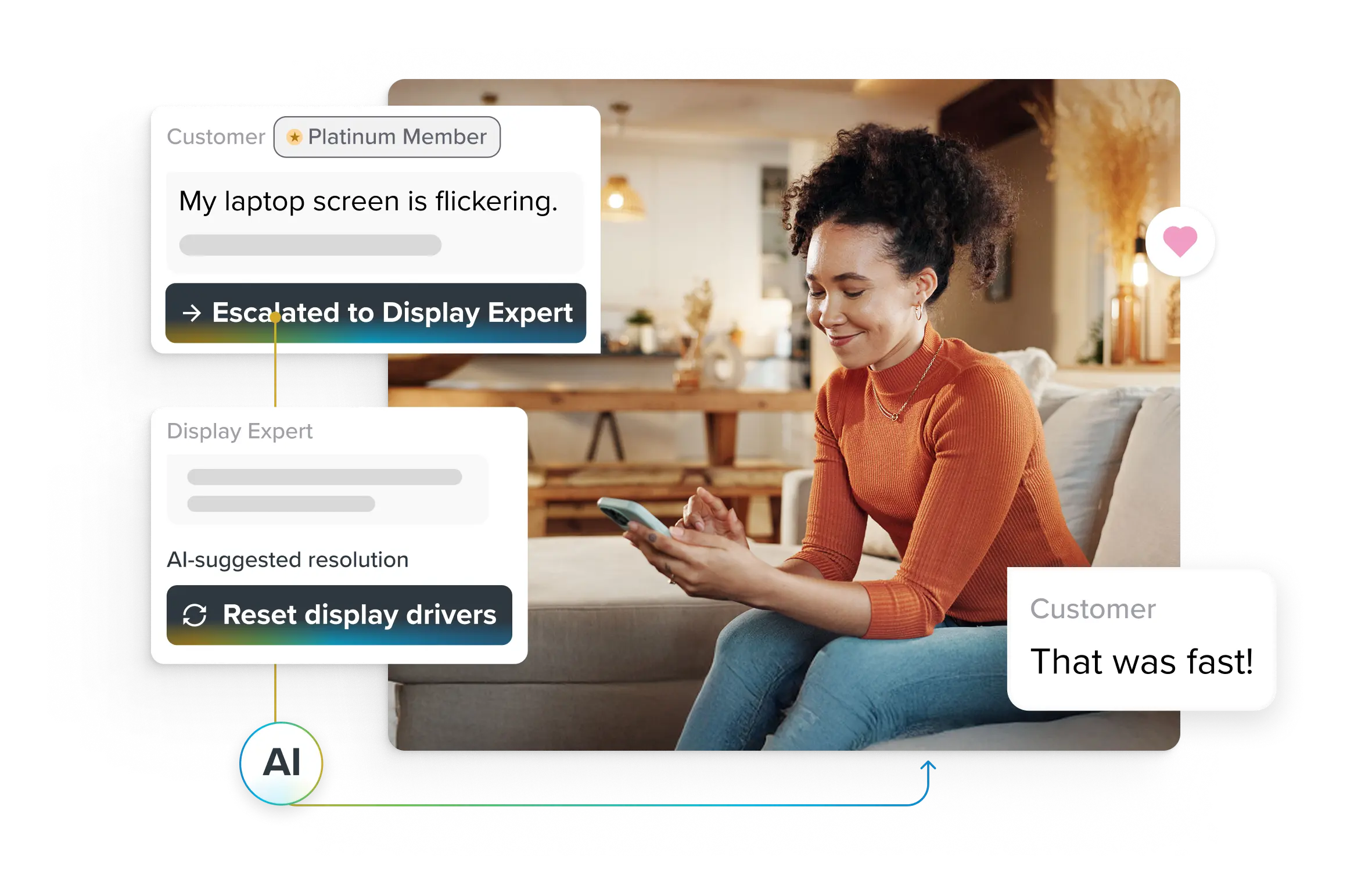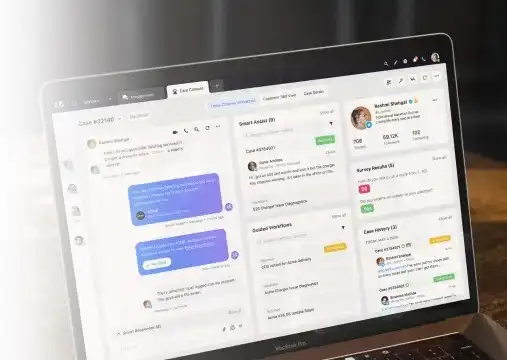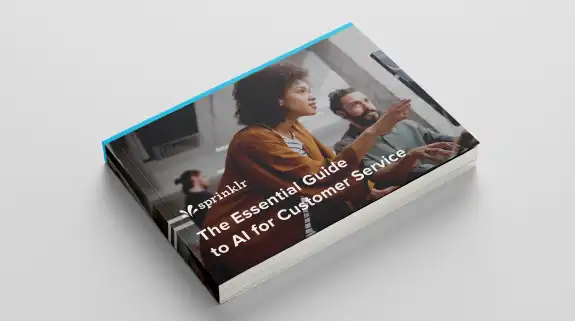Transform CX with AI at the core of every interaction
Unify fragmented interactions across 30+ voice, social and digital channels with an AI-native customer experience platform. Deliver consistent, extraordinary brand experiences at scale.

Voice Bots
- What is a voice bot?
- How do voice bots work?
- Essential components of a voice bot
- How can I create a voice bot?
- How are voice bots different from chatbots, callbots and voice assistants?
- Why should you include voice bots in your customer service strategy?
- Sprinklr’s best-of-breed voice bots improve the customer experience
What is a voice bot?
A voice bot is artificial intelligence (AI) powered software used in contact centers that can interact with inbound callers. It captures, interprets and analyzes a person’s vocal input and responds to them via voice using natural language processing (NLP) and machine learning. It, in turn, allows a caller to navigate an IVR{{Interactive Voice Response}} menu, explore self-service options and be easily transferred to live agents if necessary.
These conversational AI bots{{Conversational chat and voice bot}} can understand human language and intentions — without requiring customers to use specific programmed commands. When users have questions while browsing through your products and services, they can interact with the voice bot and receive real-time, contextualized and relevant responses.
How do voice bots work?
Voice bots can differ based on their functionalities and interaction quality. But in general, voice recognition technology works on the principle of understanding human language by encoding and decoding a spoken message.
Through machine learning, it automatically improves its data and algorithms to deliver more accurate responses continuously. A fully functional AI-powered voice bot follows this step-by-step process before finally answering a customer’s query:
Step 1. Capture input
Automated speech recognition (ASR) technology helps the bot filter out insignificant sounds to focus on understanding the customer’s spoken language, intent, and accent. The technology works as a pre-speech recognition system. It breaks down the users’ vocal input into groups of information that are easier to process than complex human speech.
Step 2. Remove background noise
Ambient sounds such as people chattering, car horns, and other disturbances are unavoidable when speaking into a microphone. These sounds can distort the relevant information in a message. However, using a neural network that functions similarly to the human brain, AI can differentiate between the actual message and the background noise.
Step 3. Process information to find a logical response
AI-driven voice bots categorize the simplified data to comprehend every element one more time. They use trained natural language processing (NLP) and natural language understanding (NLU) models to identify the actual meaning behind the message — based on user intent, sentiment analysis{{What is sentiment analysis?}}, and industry-specific use cases. This way, bots can narrow down logical and effective responses.
Step 4. Process data using syntactic and semantic techniques
A semantic analysis system helps the bot recognize the hidden context behind human sentences and words. Simultaneously, the syntactic method scrutinizes and backs up the messages using grammatical rules.
Step 5. Narrow down the final reply
After assessing the customer’s voice input, the voice bot reaches a specific range of potential answers. The voice bot then evaluates and filters those response options — finding the one that most accurately and objectively provides a solution to the customer’s inquiry.
Learn more: 7 examples of how top brands are using chatbots on messenger apps{{chatbot for brands}}
Step 6. Send out the response
An AI voice bot converts the correct answer into an audio format using a text-to-speech system. You can train this system to have a voice more relevant to industry-specific use cases. These pre-built, custom-trained intents help the voice bot pick up future conversations where the customer left off earlier — ensuring a seamless, personalized interaction.
Essential components of a voice bot
Five core components are involved in the functioning of a voice bot. These also include elements that provide additional features, such as speech recognition.
Backend technology
There is a need for a common platform in the backend of your processes to take care of messages across multiple channels and for the voice bot to function efficiently. These messages are processed using NLP (natural language processing).
The backend platform or software holds the business logic and integrates it with the actual voice bot solution, helping build up conversational intelligence. It, in turn, sets the tone for your customer conversations.
Channels
Once your backend is set up, the next step will be creating an endpoint for all the integrations inside every channel. Now, while all the individual channel integrations are different, they all follow the same process when setting them up for sending and receiving messages that depend on access token authorization.
In addition, you would also have to implement channel-specific user interface elements in places, such as graphic cards, quick replies, etc., that guide the users during a conversation.
Natural language processing
You must use an NLP service, such as Google’s natural language processing software, every time you receive a message to understand the user's intent. Though setting up an NLP service is direct, training them isn’t easy.
Gain an understanding of individual elements existing in the systems, like employee databases and work on implementing business logic validation on your extracted data. It could be as simple as a fundamental validation or customized per your needs.
Conversational Intelligence
You need to design clusters of intelligent conversations based on NLP intent. To develop an efficient voice bot, write algorithms for every navigation and use case so that nothing gets repeated. It would make it easier for the users to start from scratch. You can draft a conversation by leveraging decision trees, state workflows, and deep-learning techniques.
Integration
Usually, organizations deploy voice bots for essential functions like answering queries, booking slots, and ordering items. In such cases, integration of the bot happens in the system that the organization already has in place. It would involve factors like validations and business logic rules. In addition, voice bots can often integrated into Contact Center as a Service (CCaaS) solutions to improve customer interactions.
How can I create a voice bot?
You can create a voice bot in six simple steps:
1. Choose a platform: Several platforms offer you the technical expertise to build a voice bot, like Amazon, Google, Sprinklr and more. You choose one of them depending on your needs.
2. Define the purpose: Understand why you are creating the bot and what functions it would be performing. Will it answer FAQs, provide recommendations and take orders? Or will it be doing something completely new? Knowing the purpose(s) will help you create your bot’s conversational flow and design responses.
3. Draft a conversational flow: Design a conversation flowchart to map out all the interactions the bot will have with the users. Decide possible responses the bot will provide based on the user's questions and the possible ways the conversation can fork out from the primary intent.
4. Develop bot responses: Create your responses for your prepared conversational flows. It will be advantageous if the platform offers out-of-the-box templates to develop your bot responses.
5. Integrate it with a voice assistant: Once the bot responses are ready, integrate them with a voice assistant like Alexa. It will enable users to interact with the bot using voice commands.
6. Test it before deployment: Test the bot with a limited set of users to see if it is working as intended. You can then take feedback from your test users and leverage usage analytics to refine the bot’s performance.
Creating a voice bot is a complex process requiring specialized programming and natural language processing knowledge. It would help to have readily available software and solutions that are built for this purpose to make work easier for you.

How are voice bots different from chatbots, callbots and voice assistants?
Although voice bots, chatbots and callbots all operate using the same technology (conversational AI), they are different in practice.
Voice bots vs. chatbots
Chatbots{{What is a chatbot?}} interact with customers over text-based channels, while voice bots interact with them over voice-based channels. Because of this difference in the input type, two features differentiate voice bots from chatbots: voice recognition and speech synthesis.
Voice recognition helps transform the customer’s spoken language into a series of text-based words that an engine, similar to the type a chatbot uses, can analyze. Speech synthesis then enables the bot to convert the responses into spoken language.
Voice bots vs. callbots
Conversing with a user over a phone requires a specialized voice bot called a callbot. A voice bot can understand and solve a user’s problem autonomously (think of a voice-powered assistant on a phone or computer).
On the other hand, customer service teams use callbots — or voice bots deployed on a phone channel — to handle entire customer interactions from end to end.
Voice bots vs. voice assistants
Voice bots leverage simple automatic speech recognition to convert speech to text in the language spoken by the user. Advanced voice bots use natural language processing to get a better understanding of the user’s context.
Regarding voice assistants, they deploy four components to give the user a complete voice experience. The four components include automatic speech recognition(ASR), natural language processing, translation and text-to-speech. Due to this very reason, voice bots need more functionality in comparison to voice assistants.
Voice bots are capable of accepting voice inputs and giving relevant responses. With voice assistants, the user can do voice searches, ask questions and use the internet using their voice.
If you are ordering a dessert from a food delivery app using a voice assistant, it would delve further and ask questions like:
- The flavor you would like
- The quantity required
- If you would like a discount
Voice bots help users in their limited ways, but voice assistants sync with the applications you are in and augment your experience.

Why should you include voice bots in your customer service strategy?
Since voice is the fastest, most intuitive and basic form of communication, voice bots can elevate the level of customer service you provide — and help to speed up response times. Here are some reasons businesses should consider implementing AI-powered voice bots:
Provide instant customer support
Voice bots improve the customer experience by providing them with immediate responses. They are easy to use and always available — promising quick and customized interactions without a long wait. And their high comprehension rate makes the customer experience smoother.
Reduce service costs
As a self-service AI communication tool, voice bots automate human-like inbound and outbound interactions at scale — without human intervention. This can significantly reduce customer support costs on customer support channels{{5 cost-effective customer service channels}}.
Maximize your agents’ productivity
Voice bots are not a replacement for human agents. Instead, they are a complement. Turn high-performing service agents into a guide for others with smart AI and automation. Bots can handle simple and repetitive tasks, freeing up your live agents’ time and allowing them to focus on more complex issues that need a human touch.
Scale your contact center on demand
When your business experiences an increase in call volume, it’s possible to scale your contact center up by adding voice bots in just a few clicks. You can also turn these voice bots off during lean periods.

Sprinklr’s best-of-breed voice bots improve the customer experience
Built on the only unified customer experience management (Unified-CXM) platform{{Customer Experience Management Software}}, Sprinklr Voice Bots{{Conversational Voice}} help customer service organizations scale and handle fluctuating caseloads — without the expense of hiring more agents. Provide 24/7 human-like support to your customers, with premium features including:
- No-code, AI-powered bot models to get started building bot journeys quickly, using an intuitive UI and drag-and-drop builder
- Intent and ASR models that retrain themselves using AI-sourced customer data, resulting in an accuracy of over 90%
- Multilingual capability to build voice bots across global languages case by case, deploying new languages in just 4-6 weeks with 85% accuracy
- Text-to-speech feature to add a voice of your choice to your bot — and train the voice to resemble any preferred human voice
- Custom intents trained with over 300+ hours of customer recordings to capture essential voice-specific elements
- Custom reports to track bot performance, including the number of conversions, latency, and drop-outs so that you can identify potential areas of improvement
- Dual-tone multi-frequency signaling (DTMF)-based responses to gather and secure sensitive customer data the right way
- IVR deflection to route customers to self-service support, reducing large call volumes into experiences where customers can resolve their issues themselves — on the channels they prefer
- AI-led intuition moderation to automatically classify the conversations that need a human agent intervention

